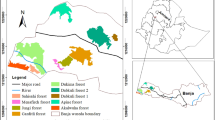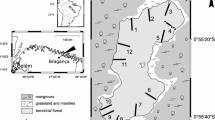Abstract
In the coastal littoral forest of extreme southeastern Madagascar, westudied tree diameter at breast height (DBH) ≥ 10 cm in 20, 50× 50 m plots in each of four forest fragments, andunderstorywoody vegetation (DBH < 10 cm, ≥1 m tall) in60,10 × 10 m plots in three of the fragments. Oneforestfragment was located in the highly degraded Lokaro region, and three in the nearbySainte-Luce forest. Atotal of 3476 trees, representing 169 species in 55 families, were recorded inthe50 × 50 m plots, and 10282 understory stems, representing195 species in 54 families, were found in the 10 × 10m plots. For each tree, DBH was recorded. Mean tree diameter andpatterns of tree size class distribution did not differ among the four forestfragments. However, the fragments differed significantly in both tree andunderstory stem densities, species richness and diversity values, and familyrichness values, with the Lokaro fragment having the lowest values for allmeasures. Furthermore, floristic patterns, family importance values, and communitysimilarity measures revealed that the species composition at theLokaro fragment was very different from the Sainte-Luce fragments. Anthropogenicdisturbance appears most pronounced in the isolated Lokaro forest, where bioticresources are limited to this single fragment.
Similar content being viewed by others
References
Anderssen M., Thornhill A. and Koopowitz H. 1997. Tropical forest disruption and stochastic biodiversity losses. In: Laurance W.F. and Bierregaard R.O. Jr (eds), Tropical Forest Remnants: Ecology, Management, and Conservation of Fragmented Communities. University of Chicago Press, Chicago, Illinois, pp. 281–291.
Barbour M.G., Burk J.H., Pitts W.D., Gilliam F.S. and Schwartz M.W. 1999. Terrestrial Plant Ecology. Benjamin/Cummings, Don Mills, Ontario.
Battistini R. and Verin P. 1972. Man and the environment in Madagascar. In: Battistini R. and Richard-Vindard G. (eds), Biogeography and Ecology in Madagascar. Dr. W. Junk, The Hague, The Netherlands, pp. 311–337.
Bierregaard R.O. Jr, Lovejoy T.E., Kapos V., dos Santos A.A. and Hutchings R.W. 1992. The biological dynamics of tropical rainforest fragments. BioScience 42: 859–866.
Brewer A. and Williamson M. 1994. A new relationship for rarefaction. Biodiversity and Conservation 3: 373–379.
Cadotte M.W. 2000. Mining in Madagascar and biodiversity loss: are there options? Biodiversity 1: 2–8.
Cadotte M.W. and Lovett-Doust J. 2002. Habitat fragmentation and anthropogenic pressure alters diversity, abundance, and demographics of a tropical forest community. Ecological Applications (submitted).
Cadotte M.W. 2001. Plant community responses to habitat fragmentation in the littoral forests of southeastern Madagascar, M.Sc. Thesis, University of Windsor, Canada.
Chauvet B. 1972. The forests of Madagascar. In: Battistini R. and Richard-Vindard G. (eds), Biogeography and Ecology in Madagascar. Dr. W. Junk, The Hague, The Netherlands, pp. 191–199.
Chittibabu C.V. and Parthasarathy N. 2000. Attenuated tree species diversity in human-impacted tropical evergreen forest sites at Kolli hills, Eastern Ghats, India. Biodiversity and Conservation 9: 1493–1519.
Condit R., Hubbell S.P., Lafrankie J.V., Sukumar R., Manokaran N., Foster R.B. et al. 1996. Species–area and species–individual relationships for tropical trees: a comparison of three 50-ha plots. Journal of Ecology 84: 549–562.
Debinski D.M. and Holt R.D. 2000. A survey and overview of habitat fragmentation experiments. Conservation Biology 14: 342–355.
Dumetz N. 1999. High plant diversity of lowland rainforest vestiges in eastern Madagascar. Biodiversity and Conservation 8: 273–315.
Ferreira L.V. and Prance G.T. 1998. Species richness and floristic composition in four hectares in the Jau National Park in upland forests in central Amazonia. Biodiversity and Conservation 7: 1349–1364.
Foster R.B. 1978. Heterogeneity and disturbance in tropical vegetation. In: Soule M.E. and Wilcox B.A. (eds), Conservation Biology: An Evolutionary-Ecological Perspective. Sinauer Associates, Inc., Sunderland, Massachusetts, pp. 75–92.
Gascon C., Lovejoy T.E., Bierregaard R.O. Jr, Malcolm J.R., Stouffer P.C., Vasconcelos H.L. et al. 1999. Matrix habitat and species richness in tropical forest remnants. Biological Conservation 91: 223–229.
Gentry A.H. 1988. Changes in plant community diversity and floristic composition on environmental and geographical gradients. Annals of the Missouri Botanical Garden 75: 1–34.
Gentry A.H. and Dodson C. 1987. Contribution of nontrees to species richness of a tropical rain forest. Biotropica 19: 149–156.
Goodman S.M. 1999. Description of the Reservé Naturelle Integrale d'Andohahela, Madagascar, and the 1995 biological inventory of the reserve. Fieldiana 94: 1–9.
Green G.M. and Sussman R.W. 1990. Deforestation history of the eastern rain forests of Madagascar from satellite images. Science 248: 212–215.
Groombridge B. 1992. Global Biodiversity: Status of the Earth's Living Resources. Chapman & Hall, New York.
Gross N.D., Torti S.D., Feener D.H. Jr and Coley P.D. 2000. Monodominance in an African rain forest: is reduced herbivory important? Biotropica 32: 430–439.
He F., Legendre P. and Lafrankie J.V. 1996. Spatial pattern of diversity in a tropical rain forest in Malaysia. Journal of Biogeography 23: 57–74.
Heck K.L. Jr, van Belle G. and Simberloff D. 1975. Explicit calculation of the rarefaction diversity measurement and the determination of sufficient sample size. Ecology 56: 1459–1461.
Helme N.A. and Rakotomalaza P.J. 1999. An overview of the botanical communities of the Reserve Naturelle Integrale d'Andohahela, Madagascar. Fieldiana 94: 11–23.
Johnston M. and Gillman M. 1995. Tree population studies in low-diversity forests, Guyana. I. Floristic composition and stand structure. Biodiversity and Conservation 4: 339–362.
Josse C. and Balslev M. 1993. The composition and structure of a dry, semi-deciduous forest in western Ecuador. Nordic Journal of Botany 14: 425–434.
Klein B.C. 1989. Effects of forest fragmentation on dung and carrion beetle communities in central Amazonia. Ecology 70: 1715–1725.
Lieberman D., Lieberman M., Hartshorn G. and Peralta R. 1985. Growth rates and age–size relationships of tropical wet forest trees in Costa Rica. Journal of Tropical Ecology 1: 97–109.
Lieberman D., Lieberman M., Peralta R. and Hartshorn G. 1996. Tropical forest structure and composition on a large-scale altitudinal gradient in Costa Rica. Journal of Ecology 84: 137–152.
Lowry P.P. II, Schatz G.E. and Phillipson P.B. 1997. The classification of natural and anthropogenic vegetation in Madagascar. In: Goodman S.M. and Patterson B.D. (eds), Natural Change and Human Impact in Madagascar. Smithsonian Institution Press, Washington, DC, pp. 280–305.
Lynam A.J. 1997. Rapid decline of small mammal diversity in monsoon evergreen forest fragments in Thailand. In: Laurance W.F. and Bierregaard R.O. Jr (eds), Tropical Forest Remnants: Ecology, Management, and Conservation of Fragmented Communities. University of Chicago Press, Chicago, Illinois, pp. 222–240.
Matthysen E., Lens L., Van Dongen S., Verheyen G.R., Wauter L.A., Adriaensen F. et al. 1995. Diverse effects of forest fragmentation on a number of animal species. Belgian Journal of Zoology 125: 175–183.
Mittermeier R.A., Myers N., Thomsen J.B., da Fonseca G.A.B. and Olivieri S. 1998. Biodiversity hotspots and major tropical wilderness areas: approaches to setting conservation priorities. Conservation Biology 12: 516–520.
Mori S.A., Boom B.M., de Carvalino A.M. and dos Santos T.S. 1983. Ecological importance of Myrtaceae in an Eastern Brazilian wet forest. Biotropica 15: 68–70.
Myers N., Mittermeier R.A., Mittermeier C.G., da Fonseca G.A.B. and Kent J. 2000. Biodiversity hotspots for conservation priorities. Nature 403: 853–858.
Nason J.D. and Hamrick J.L. 1997. Reproductive and genetic consequences of forest fragmentation: two case studies of neotropical canopy trees. Journal of Heredity 88: 264–276.
Nieder J., Engwald S., Klawun M. and Barthlott W. 2000. Spatial distribution of vascular epiphytes (including hemiepiphytes) in a lowland Amazonian rain forest (Surumoni crane plot) of southern Venezuela. Biotropica 32: 385–396.
Nussbaum R.A., Raxworthy C.J., Raselimanana A.P. and Ramanamanjato J.B. 1999. Amphibians and reptiles of the Réserve Naturelle Intégrale d'Andohahela, Madagascar. Fieldiana Zoology 94: 155–173.
Prance G.T., Beentje H., Dransfield J. and Johns R. 2000. The tropical flora remains undercollected. Annals of the Missouri Botanical Gardens 87: 67–71.
Rabevohitra R., Wilme L., Lowry P.P. and Schatz G.E. 1998. La diversité floristique et l'importance de la conservation des foret littorales de la côte Est. In: Ratsirarson J. and Goodman S.M. (eds), Inventaire Biologique de la Foret Littorale de Tampolo (Fenoarivo Atsinanana). Recherches pour le Developpement, Antananarivo, Madagascar, pp. 65–99.
Rakotomalaza P.J. and Messmer N. 1999. Structure and floristic composition of the vegetation in the Réserve Naturelle Intégrale d'Andohahela, Madagascar. Fieldiana Zoology 94: 51–96.
Razafimandimbison S.G. and Taylor C.M. 2000. A new species of the Genus Paederia (Rubiaceae) from the Petriky forest, Taolagnaro, Madagascar. Novon 10: 71–73.
Richard A.F. and O'Connor S. 1997. Degradation, transformation, and conservation. In: Goodman S.M. and Patterson B.D. (eds), Natural Change and Human Impact in Madagascar. Smithsonian Institution Press, Washington, DC, pp. 406–418.
Schatz G.E., Birkinshaw C., Lowry P.P., Randriantafka F. and Ratovoson F. 2000. The endemic plant families of Madagascar project: integrating taxonomy and conservation. In: Lourenço W.R. and Goodman S.M. (eds), Diversité et Endémisme à Madagascar. Mémoires de la Société de Biogéographie, Paris, pp. 11–24.
Shackleton C.M., Griffin N.J., Banks D.I., Mavrandonis J.M. and Shackleton S.E. 1994. Community structure and species composition along a disturbance gradient in a communally managed South African savanna. Vegetatio 115: 157–67.
Sheil D. 1995. A critique of permanent plot methods and analysis with examples from Budongo Forest, Uganda. Forest Ecology and Management 77: 11–34.
Simberloff D. 1978. Use of rarefaction and related methods in ecology. In: Dickson K.L., Cairns J. Jr and Livingston R.J. (eds), Biological Data in Water Pollution Assessment: Quantitative and Statistical Analyses, ASTM STP 652. American Society for Testing and Materials, Philadelphia, Pennsylvania, pp. 150–165.
Somanathan H. and Borges R.M. 2000. Influence of exploitation on population structure, spatial distribution and reproductive success of dioecious species in a fragmented cloud forest in India. Biological Conservation 94: 243–256.
SPSS 1999. SYSTAT 9. SPSS Inc., Chicago, Illinois.
Sussman R.W. and Rakotozafy A. 1994. Plant diversity and structural analysis of a tropical dry forest in southwestern Madagascar. Biotropica 26: 241–254.
Torti S.D., Coley P.D. and Kursar T.A. 2001. Causes and consequences of monodominance in tropical lowland forests. American Naturalist 157: 141–153.
Turner I.M. 1996. Species loss in fragments of tropical rain forest: a review of the evidence. Journal of Applied Ecology 33: 200–209.
Underwood A.J. 1997. Experiments in Ecology. Cambridge University Press, Cambridge, UK.
Vane-Wright R.I., Humphries C.J. and Williams P.H. 1991. What to protect? – Systematics and the agony of choice. Biological Conservation 55: 235–254.
Wilcove D.S., McLellan C.H. and Dobson A.P. 1986. Habitat fragmentation in the temperate zone. In: Soule M.E. (ed.), Conservation Biology: The Science of Scarcity and Diversity. Sinauer Associates, Sunderland, Massachusetts, pp. 237–256.
Author information
Authors and Affiliations
Rights and permissions
About this article
Cite this article
Cadotte, M.W., Franck, R., Reza, L. et al. Tree and shrub diversity and abundance in fragmented littoral forest of southeastern Madagascar. Biodiversity and Conservation 11, 1417–1436 (2002). https://doi.org/10.1023/A:1016282023542
Issue Date:
DOI: https://doi.org/10.1023/A:1016282023542




